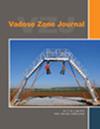A new exponential model for predicting soil gas diffusivity with varying degree of saturation
IF 2.5
3区 地球科学
Q3 ENVIRONMENTAL SCIENCES
引用次数: 2
Abstract
Soil gas diffusivity (Dp/Do, gas diffusion coefficients in soil and in free air, respectively) and its relation to soil moisture is of great importance for describing and quantifying essential provisional and regulatory functions associated with terrestrial ecosystems such as soil aeration and greenhouse gas (GHG) emissions. Because gas migration in terrestrial soil systems is predominantly diffusion controlled, soil gas diffusivity becomes a fundamental prerequisite to quantify diffusive gas fluxes. Descriptive–predictive models are often used to estimate Dp/Do from easily measurable soil physical properties. Most of the available models take the form of power‐law functions and often tend to mischaracterize soil moisture effects at high moisture regimes. Based on a wide range Dp/Do data available in literature representing both intact and repacked soils, this study developed a novel air‐saturation‐dependent exponential (ASEX) gas diffusivity model to model Dp/Do in relation to soil air saturation. The model variable α, which represents the diffusivity at half air saturation normalized by the same in complete soil air saturation, could potentially differentiate moisture effects on different soil structural states. For specific applications in intact soils, we propose corresponding α values for upper‐limit (α = .6) and lower‐limit (α = .05) estimates of diffusivity, while an average value (α = .3) for general applications in both intact and repacked soils. As expected, our model based on a few a priori measured supportive data showed a better performance over the classical predictive models that do not use such measurements. The new model was further used to derive useful implications to showcase soil density effects on Dp/Do.一种预测不同饱和度土壤气体扩散系数的指数模型
土壤气体扩散率(Dp/Do,分别是土壤和自由空气中的气体扩散系数)及其与土壤湿度的关系对于描述和量化与陆地生态系统相关的基本临时和调节功能(如土壤通气和温室气体排放)具有重要意义。由于陆地土壤系统中的气体迁移主要受扩散控制,土壤气体扩散率成为量化扩散气体通量的基本前提。描述性-预测性模型通常用于根据易于测量的土壤物理特性来估计Dp/Do。大多数可用的模型采用幂律函数的形式,往往会错误地描述高水分条件下的土壤水分效应。基于文献中代表完整土壤和重新包装土壤的广泛Dp/Do数据,本研究开发了一个新的空气饱和度相关指数(ASEX)气体扩散率模型,以模拟与土壤空气饱和度相关的Dp/Do。模型变量α表示半空气饱和度下的扩散率,该扩散率由完全土壤空气饱和度下相同的扩散率归一化,可以潜在地区分水分对不同土壤结构状态的影响。对于完整土壤中的特定应用,我们提出了扩散率上限(α=.6)和下限(α=.05)估计值的相应α值,而完整土壤和重新包装土壤中的一般应用的平均值(α=.3)。正如预期的那样,我们基于一些先验测量支持数据的模型显示出比不使用此类测量的经典预测模型更好的性能。新模型被进一步用于推导有用的含义,以展示土壤密度对Dp/Do的影响。
本文章由计算机程序翻译,如有差异,请以英文原文为准。
求助全文
约1分钟内获得全文
求助全文
来源期刊

Vadose Zone Journal
环境科学-环境科学
CiteScore
5.60
自引率
7.10%
发文量
61
审稿时长
3.8 months
期刊介绍:
Vadose Zone Journal is a unique publication outlet for interdisciplinary research and assessment of the vadose zone, the portion of the Critical Zone that comprises the Earth’s critical living surface down to groundwater. It is a peer-reviewed, international journal publishing reviews, original research, and special sections across a wide range of disciplines. Vadose Zone Journal reports fundamental and applied research from disciplinary and multidisciplinary investigations, including assessment and policy analyses, of the mostly unsaturated zone between the soil surface and the groundwater table. The goal is to disseminate information to facilitate science-based decision-making and sustainable management of the vadose zone. Examples of topic areas suitable for VZJ are variably saturated fluid flow, heat and solute transport in granular and fractured media, flow processes in the capillary fringe at or near the water table, water table management, regional and global climate change impacts on the vadose zone, carbon sequestration, design and performance of waste disposal facilities, long-term stewardship of contaminated sites in the vadose zone, biogeochemical transformation processes, microbial processes in shallow and deep formations, bioremediation, and the fate and transport of radionuclides, inorganic and organic chemicals, colloids, viruses, and microorganisms. Articles in VZJ also address yet-to-be-resolved issues, such as how to quantify heterogeneity of subsurface processes and properties, and how to couple physical, chemical, and biological processes across a range of spatial scales from the molecular to the global.
 求助内容:
求助内容: 应助结果提醒方式:
应助结果提醒方式:


